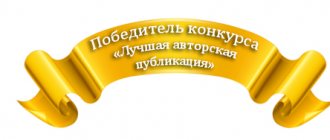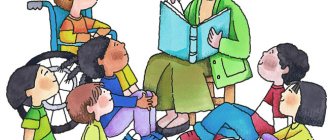Greetings. Speech topic message
Today we will talk about the speech development of our first-graders, about existing problems and ways to solve them. At the beginning of my speech, I will tell you what the speech of a child who is ready for school should be like, what a first-grader should be able to do with normal speech development.
Slide number 1
- pronounce all speech sounds clearly;
- determine the place of a sound in a word (phonemic hearing must be sufficiently developed) (at the beginning, in the middle, at the end);
- pronounce words syllable by syllable; (a sense of rhythm must be developed)
- make sentences of 3-5 words;
- use generalizing concepts; (bear, fox, wolf are animals)
- make up a story based on the picture;
- master the processes of word formation and inflection. (be able to form words using suffixes - house - house, drum - drummer; prefixes - ran-ran; etc., change words by gender, number, etc.)
In addition to all of the above, the child must have at least 2000 words in his vocabulary.
Slide number 2
At the beginning of the school year, I conducted a survey of the speech status of students in grades 1a and 1b. The survey results showed that the vast majority of children have speech disorders of various types.
Out of 47 1st grade students, 25 students were identified with speech impairment OPD level III 10 people OPD level IV 3 people FFF 11 people LGNR 1 person
These diagnostic results show that many children at the beginning of their education remain unformed in all aspects of speech: sound pronunciation, vocabulary, grammatical structure, and their phonemic hearing is also underdeveloped. It is worth mentioning that this picture is observed not only in our school. The problem of speech development is relevant for all first-graders in our country.
Order the original presentation: This e-mail address is being protected from spambots. You need JavaScript enabled to view it.
All presentations here
Slide number 3
Sound pronunciation suffers in almost all children of two classes. The sounds of different groups, both R and L sonors, as well as hissing and even whistling sounds, which should be present in a child at 3-4 years of age, are disrupted. And if the distortion or absence of the sound P cannot interfere with the mastery of educational material, then the violation of the pronunciation of other sounds is a serious obstacle to the mastery of the school curriculum.
The formation of sound pronunciation is negatively affected by the immaturity of phonemic hearing, which is also observed in children. Tasks to determine the place of a sound in a word caused great difficulty for many. The state of the lexical and grammatical structure of children's speech is also alarming. The students' vocabulary is very poor.
Children use simple sentences in speech and have difficulty choosing the right words to describe objects, weather, and express their feelings. Do not use compound prepositions in the flow of speech (due = from, from under = from). They make multiple mistakes in inflection (one bucket - five buckets, one ear - five ears, etc.), they do not know how to form new words (who inserts the glass - a glazier, whose tail is the wolf's tail? Volkin). All these speech disorders will certainly lead to new problems - reading and writing disorders, dyslexia and dysgraphia.
Slide No. 4 Definition of dyslexia and dysgraphia
Slides No. 5, 6, 7, 8 Examples of manifestations of writing disorders
If you do not notice these mistakes in time and do not try to correct them, then dysgraphia will manifest itself at the end of the school year, and in the 2nd grade it will bloom in full bloom. Therefore, you, parents, need to look at your students’ copybooks as carefully as possible. It is important to notice dysgraphic errors in time and begin to correct the problem. A reminder that you can take after the meeting will help you with this, along with a booklet of a selection of games for developing phonemic awareness.
Slide number 9
The development of dysgraphia and dyslexia can be prevented. Only through the joint efforts of the teacher, speech therapist, parents and the student himself can a positive result be achieved. To date, out of 25 first grade students, 13 are enrolled in the logo center, the remaining 12 will be enrolled gradually, to take the place of dropped out children.
Slide number 10
Corrective work at the speech point is carried out in such areas as: Staging, automation, differentiation of problem sounds; Development of phonemic processes (phonemic hearing, ideas, perception); Development of the lexical and grammatical side of speech.
Slide number 11
Parents’ tasks: 1. Motivate the child to attend correctional classes 2. Carry out tasks given by the speech therapist together with the child 3. Monitor the child’s speech, correct speech errors
Slide number 12
Errors that indicate writing problems
- Omissions, insertions and rearrangements of letters: paka, palkta or pakla instead of palka.
- Substitutions and mixtures of letters denoting similar sounds: year - cat, kidney - barrel;
- “Motor” errors associated with hand movements: *extra elements for letters (Ш with extra “squiggles”); * unfinished letters (lack of “squiggles” in Ш, И or М); * “stuck”, a complete repetition of the previous letter: aarmelon instead of watermelon.
- Errors related to visual perception. Most often, children confuse letters that are visually similar to each other, for example, capital M - T - Sh; I - Sh.
Slide number 13
Thank you for your attention
Author of the material: Pister Elena Vladimirovna
Also on topic:
Speech therapist for parents - speech readiness for school
Speech therapy lounge for parents. Parent meeting
Author: Rytova Olesya Aleksandrovna, teacher-speech therapist, State Budgetary Educational Institution Secondary School No. 1 SP “Kindergarten No. 8 “Topolek”, Chapaevsk, Samara Region
The purpose of the event: development of cooperation and activation of parents of preschool children through the expansion of pedagogical, psychological and speech therapy knowledge.
Tasks:
- Give an idea of such speech disorders as “Dyslalia” and “Mild dysarthria”;
- Introduce games aimed at developing fine motor skills, phonemic hearing, articulatory apparatus and the correct type of breathing;
- Introduce games to develop the emotional sphere and positive self-esteem of preschool children;
- Creating a positive emotional background during joint activities of parents and children.
Equipment:
- speech by a speech therapist (Appendix 1);
- questionnaires for parents (Appendix 2);
- paper, glue, multi-colored napkins, fruit templates, colored pencils;
- ball, cut subject pictures;
- a set of exercises for articulation gymnastics (Appendix 3);
- memo for parents (Appendix 4).
Event plan:
- Filling out forms by parents.
- Game "Tangle".
- Speech by a speech therapist “The concept of “Dysarthria” and “Dyslalia”, the reasons for their occurrence”;
- “Creative moment with children” (development of sensorimotor skills);
- Logori element;
- "Fun Zoo" (stations);
- Game "Scream like an animal"
- Make an image of an animal;
- Reflection, summing up.
Organizing time:
Progress of the meeting:
1. After all the parents have gathered, the kindergarten speech therapist opens the living room, welcoming parents and children. Offers to “get acquainted”: Game “Tangle” Purpose: to introduce the participants of the living room to each other, evoke positive emotions and relieve tension and constraint. Equipment: soft and cute toy. Progress of the game : adults form a circle in the center of the hall, and their child stands opposite each parent. The speech therapist gives one of the kids a toy with the words: “Hello, I’m Mishka-Toptyzhka. I really, really love meeting such cute, smart kids and their kind parents. I would really like to meet you. And you? Please tell me your name and the name of your mother (father)” (this is how all the guys take turns getting to know the bear).
2. After meeting, the teacher-speech therapist conducts a theoretical seminar for parents about the most common types of speech disorders: mild forms of dysarthria and dyslalia (concept, causes, forms, features of manifestation). At this time, the teacher organizes an activity with children, where children, together with an adult, can make crafts or perform creative work “Gifts of Autumn.” Goal: development of fine muscles of the hands and fingers. Using the finished template, the guys cut out an apple or a pear and select the napkins according to the color. Then the napkins are torn off, squeezed and glued to the base of the fruit.
3. The trip to the “Jolly Zoo” takes place on an improvised train (an element of logorhythmics). At the zoo stations, adults and children will perform a variety of tasks and exercises that can be used at home. Element of logorhythmics Purpose: to develop a sense of tempo and rhythm in children, imitation and attention. Description. Parents and children become a “train” behind the speech therapist teacher. The speech therapist teacher reads a poem, accompanying it with movements along the text.
We are traveling on the train: “Hurray, hurray, hurray!” The wheels are knocking and knocking: “Ta-ta! Ta-ta! Ta-ta! Pine trees, spruce trees, and houses flash past. The wheels are knocking and knocking, “Yes, yes! Yes Yes! Yes Yes!" And in the zoo there are foxes and an elephant and a camel. We'll come to the zoo, how fun it is here!
In order to divide all parents into 2 groups, they are given “tickets” consisting of 2 colors. The color of the ticket matches the color of the zoo's "station".
4. The entire space of the hall is divided into 2 “stations”, where the speech therapist and educator are located. There is a soft toy on each table, and it will greet the kids.
Table 1 – “Let’s meet the baby elephant” This station features:
Goal: to teach parents how to perform exercises correctly.
These exercises are demonstrated by the speech therapist himself using the “Speech Therapy Frog” speech therapy simulator.
Purpose: to draw the attention of parents to the type of breathing of children, to show parents a set of breathing exercises to produce a targeted air stream.
Equipment:
"Leaves"
. The child takes the leaf by the thread and blows smoothly until the leaf bends back.
"Ships"
. For this task you need a bowl of water and light plastic toys or paper boats. The children’s task is to “send” their boat to the other side (in the form of a competition)
Tasks: Choose pictures with a certain sound; Make a sentence with these pictures;
In what part of the word is the sound hidden (beginning, middle, end of the word)
Games: “Noisy boxes”
- these can be ordinary boxes in which various types of cereals, nails, buttons are poured, in general, something that sounds different. The baby closes his eyes, and the adult makes noise with these boxes in front of the child’s ear (to begin with, take 2 boxes). Afterwards, the child opens his eyes and listens to the boxes again, remembering which box came first.
"Beating the Rhythm"
- the adult beats out a certain rhythm on the table with a pencil or fingers, and the child must repeat after him.
Table 2 “Let’s meet the baby camel.” This station presents a teacher's game to develop positive self-esteem in preschool children
“I am in the rays of the sun” A child and an adult draw the sun. Instructions: “On every ray of sunshine, write the positive qualities of the child.” The child voices all his rays, the adult helps him by writing down these qualities. At the end of the “journey,” adults and children take their seats. The speech therapist teacher welcomes the “travelers” and offers to choose envelopes with a new, interesting task. Children choose envelopes with pictures of animals and birds.
Assignment: for a team (parent + child) to lay out an animal or bird from a cut-out picture and show how this animal screams, show its behavior. Note: if someone is at a loss as to what sound to make, a “hint” is placed on the back of the picture. The pictures are selected taking into account the most common speech disorders of children, for example, the growl of a tiger: “R-r-r-r”, the hissing of a snake: “Sh-sh-sh-sh”.
At the end of the pedagogical lounge, the teacher conducts reflection with parents: he invites them to analyze the results of joint work, give an assessment and make suggestions. Parents are given “Memos” with a basic set of articulation exercises and advice from a speech therapist teacher.
Applications:
- Appendix 1. Speech by a speech therapist “The concepts of “Dysarthria” and “Dyslalia”, the reasons for their occurrence”
- Appendix 2. Questionnaire for parents of students with speech impairments
- Appendix 3. Articulation gymnastics
- Appendix 4. Memo to parents
Bibliography
- Wiesel T.G. How can I get my speech back? - M., 2001.
- Speech therapy: Textbook for students of defectology. fak. ped. universities / Ed. L.S. Volkova, S.N. Shakhovskaya. - M.: 2003.
- Martynova R.I. Comparative characteristics of children suffering from mild forms of dysarthria and functional dyslalia // Reader on speech therapy: Textbook for students of higher and secondary special pedagogical educational institutions: In 2 vols. T1./ Ed. L.S. Volkova and V.I. Seliverstova. — M.: Humanite. Ed. VLADOS Center, 1997.
- Osmanova I.S. Games and exercises for children 5-6 years old. St. Petersburg, 2007.
- Pay F. F. Techniques for correcting deficiencies in the pronunciation of phonemes // Fundamentals of the theory and practice of speech therapy. - M., 1968.
- Filicheva T.B. et al. Fundamentals of speech therapy: Textbook. manual for pedagogical students. Institute for specialties “Pedagogy and psychology (preschool)” / T. B. Filicheva, N. A. Cheveleva, G. V. Chirkina. - M.: Education, 1989.
- Fomicheva M.F. Education of correct pronunciation. - M., 1971.
- Pozhilenko E.A. “Articulation gymnastics” - St. Petersburg, 2009



